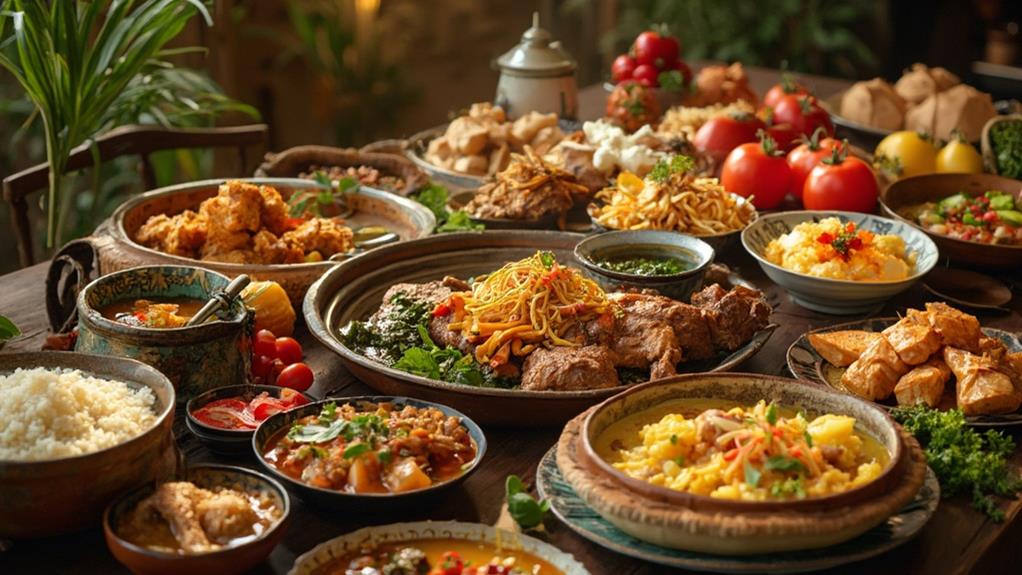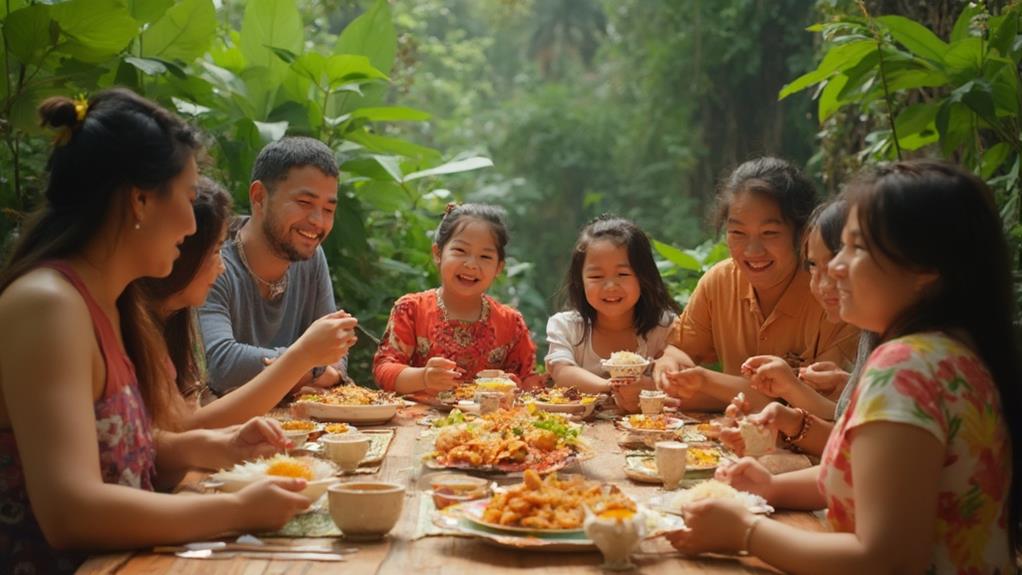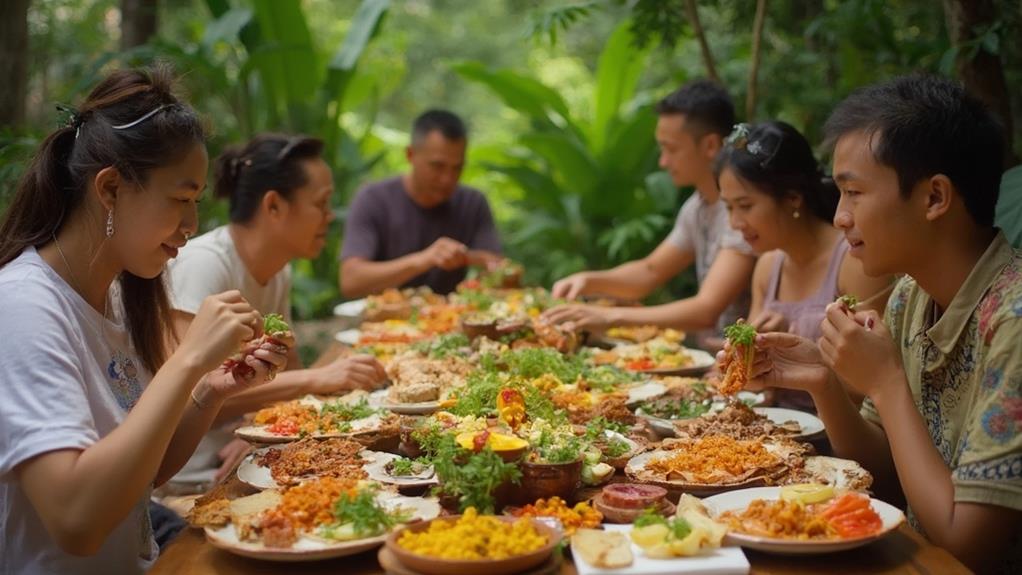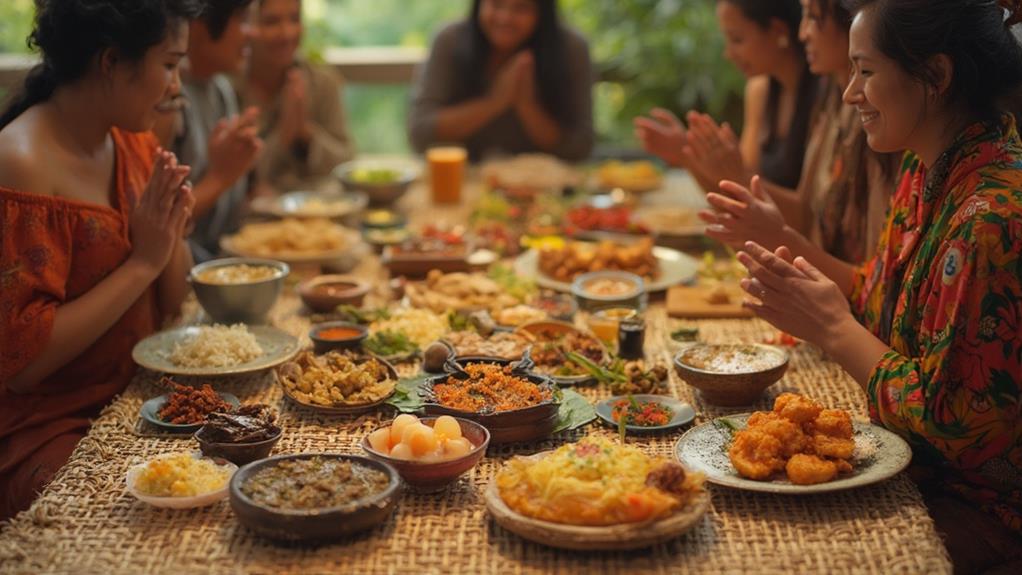Mindful eating is crucial in Filipino culture as it fortifies family bonds and deepens appreciation for the rich culinary heritage. When gathering around the table, savoring each bite allows you to create memories and foster connections with family and friends.
Traditional dishes like adobo and sinigang evoke emotions and express gratitude for cultural heritage. By slowing down and sharing meals, you cultivate a sense of community and belonging.
This practice enables individuals to appreciate the vibrant colors, aromas, and flavors of traditional dishes, honoring their cultural roots.
Historical Context of Filipino Dining
Filipino dining has a rich cultural heritage shaped by centuries of diverse influences. The history of Filipino cuisine reflects the country's blending of indigenous practices with Spanish, Chinese, and American cultures. Each wave of influence introduced new ingredients and cooking techniques, enriching the culinary landscape.
Communal meals have long been a way to bond with family and friends in Filipino culture. In earlier times, meals centered around rice, fish, and vegetables, bringing people together. This tradition continues to play a vital role in Filipino dining today.
The introduction of dishes like adobo and sinigang showcases the melding of cultural influences. These dishes, which combine indigenous, Spanish, and Chinese flavors, resonate with many Filipinos.
Adobo, a stew made with vinegar, soy sauce, and garlic, is a staple dish that reflects the country's cultural fusion.
Food extends beyond mere sustenance in Filipino culture; it embodies hospitality and warmth. When you share a meal, you're not just enjoying flavors – you're participating in a cultural narrative that honors heritage and community.
Understanding this historical context allows you to appreciate the depth of Filipino dining, making your experience not just about the food on your plate but the stories and traditions that come with it.
The Role of Food in Family Bonds
Food is a vital thread that weaves together shared experiences and memories in Filipino families. When families gather around the dining table, meals become more than just nourishment; they foster connection, laughter, and storytelling, creating a rich tapestry of familial bonds that deepen with each meal.
Traditional meals involve everyone's participation, whether it's preparing ingredients or sharing stories while cooking. This collective effort helps family members appreciate not just the food, but also the love and effort that goes into every dish. Each meal carries history, reflecting family traditions that can be passed down to future generations.
For example, lechon roasting, a centuries-old practice, symbolizes celebration and community spirit, making it a staple in many Filipino gatherings.
Food is central to community and belonging in Filipino culture, where celebrations, holidays, or even casual get-togethers are marked by feasting. When families share a meal, they're not just eating; they're nurturing relationships and creating lasting memories. This is an opportunity to reconnect, share joys, and even navigate challenges together.
Mindful eating allows families to be present during these moments, enhancing their appreciation for the flavors and the people around them. In this way, food becomes a powerful symbol of love, unity, and continuity within Filipino families.
Traditional Filipino Meals and Ingredients

Filipino cuisine is characterized by a diverse array of traditional meals and ingredients that reflect the country's rich cultural heritage.
Each dish tells a story, blending flavors from various regions and influences. Rice, seafood, and tropical fruits are staple ingredients that create a comforting familiarity in many Filipino meals.
Traditional Filipino meals often feature a combination of key ingredients, which vary depending on the dish. For example:
| Traditional Meal | Key Ingredients |
|---|---|
| Adobo | Chicken, soy sauce, vinegar |
| Sinigang | Pork, tamarind, vegetables |
| Lechon | Whole roasted pig |
| Kare-Kare | Oxtail, peanut sauce, vegetables |
| Pancit | Noodles, vegetables, meat |
These traditional meals not only satisfy hunger but also invite individuals to experience the heart and soul of Filipino culture. Sharing and enjoying food together is an essential part of Filipino culture, reinforcing bonds and traditions. By embracing these ingredients and meals, individuals can deepen their connection to Filipino heritage and the people who cherish them.
Mindful Eating Practices in Filipino Culture
Mindful eating practices can enrich your experience of Filipino cuisine by allowing you to truly savor each bite while connecting with the culture. In Filipino households, meals often begin with a moment of gratitude, reflecting the importance of appreciating the food on your plate. This is evident in the effort put into preparing dishes like adobo, a traditional Filipino stew made with marinated meat or seafood, and sinigang, a sour soup made with tamarind broth.
Focus on the textures and flavors of Filipino dishes to fully appreciate their complexity. For example, the crunch of fresh vegetables, the tanginess of tamarind, or the savory notes of marinated meats create a symphony of tastes that deserve your full attention.
Slow down and enjoy the company of those around you, rather than rushing through your meal.
Engaging all your senses can deepen your appreciation for traditional ingredients, such as fragrant garlic and the vibrant colors of vegetables. This mindful approach allows you to embrace a cultural experience that celebrates history, community, and love.
When you practice mindful eating, you're not just filling your stomach; you're immersing yourself in the rich tapestry of Filipino culinary traditions.
The Significance of Sharing Meals

Sharing meals is a vital part of Filipino culture, going beyond just eating to foster connections and create lasting memories. When families and friends gather around the table, they not only nourish their bodies but also strengthen bonds and build relationships.
Food serves as a medium for connection in Filipino culture. The Parada Ng Lechon festival in Balayan, Batangas, is a prime example of this, where over 1000 creatively dressed lechons are paraded, symbolizing prosperity and festivity. This festival highlights the importance of community spirit, hospitality, unity, and gratitude in Filipino culture.
Sharing meals encourages open conversations and a sense of belonging. Dishes are often served family-style, promoting everyone to share and savor the flavors together. This practice reflects the Filipino belief that food is a gift, meant to be enjoyed collectively. As people share laughter and stories, a simple meal becomes a cherished event.
Sharing meals allows people to honor traditions and cultural heritage. Recipes are passed down through generations, and by participating in this ritual, individuals contribute to a legacy that celebrates love, respect, and community.
So, the next time you sit down to eat with others, remember that it's more than just food – it's an experience that nurtures your spirit.
Celebrations and Communal Eating
Celebrations and Communal Eating in Filipino Culture
Communal eating is a vibrant expression of joy and togetherness in Filipino culture. During special occasions like fiestas and birthdays, sharing food goes beyond just eating together; it strengthens bonds and creates lasting memories. Each dish served tells a story, reflecting the heritage and love poured into every recipe.
Traditional Philippine folk dances and communal eating during celebrations promote a sense of national identity and unity.
Food is more than sustenance; it's a language of affection and celebration. When gathering with family and friends, everyone contributes to the meal, whether it's a favorite dish or a traditional delicacy. This sharing of food creates a sense of belonging, making every meal a cherished event in Filipino life.
The act of eating shifts from a solitary task to a communal experience. During celebrations, people are encouraged to slow down, appreciate the flavors, and engage with those around them. This mindful approach to eating fosters a sense of togetherness and unity, making every meal a special occasion.
Health Benefits of Mindful Eating

Health Benefits of Mindful Eating
Practicing mindful eating during celebrations can foster a deeper connection with others and improve overall well-being. Mindful eating is more than just savoring each bite; it's about embracing the experience and listening to your body.
Improved Digestion
Chewing slowly allows your body to break down food more effectively, making nutrients easier to absorb.
When you eat slowly, your body can break down carbohydrates, proteins, and fats more efficiently, leading to better nutrient absorption.
Weight Management
By tuning into hunger cues, you're less likely to overeat, helping you maintain a healthy weight.
Paying attention to your body's hunger and fullness signals can prevent overeating and lead to a healthier weight.
Enhanced Enjoyment
Focusing on flavors and textures can make meals more satisfying, reducing the urge to snack mindlessly later.
Savoring your food can increase satisfaction, making you less likely to reach for unhealthy snacks between meals.
Stress Reduction
Mindful eating can serve as a form of meditation, helping you relax and enjoy the present moment.
Eating mindfully can calm your mind and reduce stress, making mealtime a more enjoyable experience.
Incorporating mindfulness into your meals can lead to a healthier lifestyle, enriching both your physical health and cultural experiences.
How Does Mindful Eating Contribute to Building Community and Social Connections in Filipino Culture?
In Filipino culture, food plays a vital role in building community and social connections. Mindful eating, or being present and appreciative during meals, fosters deeper connections among family and friends. It encourages sharing and communication, ultimately strengthening the bonds within the community. Food building community and social connections is an integral part of Filipino culture.
Mindfulness Techniques for Everyday Meals
Incorporating Mindfulness into Everyday Meals
Incorporating mindfulness techniques into your everyday meals can profoundly enhance your dining experience.
By becoming more present during meals, you not only savor your food but also connect more deeply with your culture and traditions.
Slow Down
Take your time to eat; chew slowly and savor each bite. This allows you to appreciate the flavors, textures, and aromas of your food.
Engage Your Senses
Notice the colors, textures, and aromas of your food. For example, observe the vibrant colors of a fresh salad or the crispy texture of a perfectly baked cookie.
Express Gratitude
Acknowledge the effort that went into preparing your meal. Recognize the hard work of the farmers, cooks, and others involved in getting your food from farm to table.
Focus on the Moment
Eliminate distractions like TV or phones to fully immerse yourself in the experience. This helps you focus on the taste, smell, and company, making mealtime more enjoyable.
Share the Meal
Eat with family or friends to foster connection and shared appreciation. Sharing meals with others can strengthen relationships and create lasting memories.
Cultural Rituals Surrounding Food

Filipino meals are deeply rooted in cultural rituals that make dining a meaningful experience. These rituals create a sense of belonging and appreciation for the food on the plate.
Sharing and community are essential in Filipino dining. The concept of Bayanihan Spirit emphasizes sharing dishes and serving one another, fostering community and togetherness. This spirit is evident in the way Filipinos gather around the table, sharing food and stories.
Gratitude is expressed before each meal. Filipinos often offer a short prayer or say "Salamat" (thank you) before eating, expressing gratitude for the food and those who prepared it.
Mealtimes are invitations to gather. The phrase "Kain tayo!" (let's eat) is commonly used to invite everyone to eat together, emphasizing the importance of sharing meals with others.
Food is often tied to special occasions. Filipino cuisine is deeply connected to festive celebrations, allowing people to connect with their heritage while savoring traditional recipes.
For example, roasted pigs are often served at festivals like Parada Ng Lechon, showcasing the country's passion for traditional cuisine and cultural heritage.
Embracing Mindful Eating Today
Embracing mindful eating today means reconnecting with the essence of Filipino culture and its food-related rituals.
Slowing down during meals allows you to appreciate the vibrant colors, smells, and flavors of each dish, enhancing your dining experience and fostering gratitude for the labor that goes into preparing traditional meals. For example, taking a moment to acknowledge the effort that went into cooking a traditional Filipino dish like adobo or sinigang can evoke a sense of appreciation and respect for cultural heritage.
Preserving cultural heritage through traditional practices, such as folk dances and rituals, can bring a sense of national pride and identity.
Sharing stories during meals can deepen this connection, allowing food to serve as a bridge between generations. For instance, sharing stories about the origins of a traditional dish or the cultural significance of a particular ingredient can create a sense of community and shared identity.
Engaging your senses while eating encourages healthier choices.
Savoring each bite helps you become more attuned to what your body needs, honoring your hunger and fullness cues. This aligns with the Filipino value of respeto (respect) for oneself and others, promoting a healthier relationship with food.
